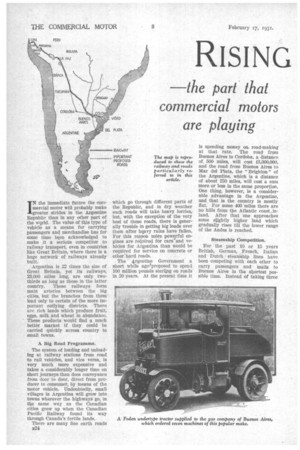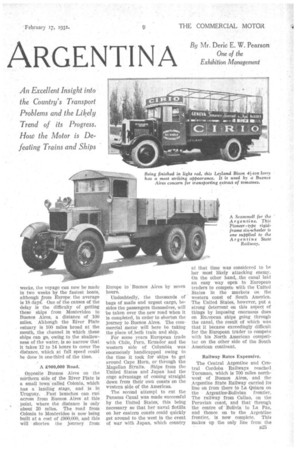RISING
Page 52

Page 53

Page 54

If you've noticed an error in this article please click here to report it so we can fix it.
ARGENTINA
the part that commercial motors are playing
An Excellent Insight into the Country's Transport Problems and the Likely Trend of its Progress. How the Motor is Defeating Trains and Ships
By Mr. Deric E. W. Pearson One of the
Exhibition Management
IN the immediate futtire the commercial motor will probably make greater strides in the Argentine Republic than in any other part of the wqrld. The value of this type of vehicle as a means for carrying passengers and Merchandise has for some time been acknowledged to make it a serions competitor to railway transport, even in countries like Great Britain, where there is a huge network of railways already built.
Argentina is 22 times the size of Great Britain, yet its railways, 23,000 miles long, are only twothirds as long as those in the latter country. These railways form main arteries between the big cities, but the branches from them lead only to certain of the more important outlying districts. There are rich lands which produce fruit, eggs, milk and wheat in abundance. These products would find a much better market if they could be carried quickly across country to small towns.
A Big Road Programme.
The system of loading and unloading at railway stations from road to rail vehicles, and vice versa, is very much more expensive and takes a considerably longer time on short journeys than does conveyance from door to door, direct from producer to consumer, by means of the motor vehicle. Undoubtedly, small villages in Argentina will grow into towns wherever the highways go, in the same way as the Canadian cities grew up when the Canadian Pacific Railway found its way through Canada's fertile lands.
There are many fine earth roads B24 which go through different parts of the Republic, and in dry weather such roads will take heavy lorries, but, with the exception of the very best of these roads, there is generally trouble in getting big loads over them after heavy rains have fallen. For this reason inOre powerful engines are re?pfired for ears-and vehicles for Argentina than would be required for service on concrete or other`hard roads.
The Alrgentine Government a short while agorproposed to spend 100 million pounds sterling on roads in 20 years. At the present time it is spending money on. road-making at that rate. The road from Buenos Aires to Cordoba. a distance of 500 miles, will cost £5,000,000, and the road from Buenos Aires to Mar del Plata, the " Brighton " of the Argentine, which is a distance of about 250 miles, will cost a sum more or less in the same proportion. One thing, however, is a considerable advantage in the Argentine, and that is the country is mostly flat. For some 400 miles there are no hills from the Atlantic coast inland. After that one approaches some slightly higher land which gradually rises till the lower range of the Andes is reached.
Steamship Competition.
For the past 10 or 15 years British, German, ,French, Italian and Dutch stearriship lines have been competing with each other to carry passengers and mails to Buenos Aires in the shortest possible time. Instead Of taking three weeks, the voyage can now be made in two weeks by the fastest boats, although from Europe the average is 18 days': One of the causes of the delay is the difficulty of getting these ships from Montevideo to Buenos Aires, a distance of 100 miles. Although the River Plate estuary is 100 miles broad at the mouth, the channel in which these ships can go, owing to the shallowness of the water, is so narrow that it takes 12 to 14 hours to cover the distance, which at full speed could he done in one-third of the time.
A £900,000 Road.
Opposite Buenos Aires •on the northern side of the River Plate is a small town called Colonia, which has a' landing stage, and is in Uruguay. Past launches can ruri across from Buenos Aires at this point, where the distance is only about 20 miles. The road from Colonia to Montevideo is now being built at a cost of £800,000, and this will shorten the journey from Europe to' Buenos Aires by seven hours.
Undoubtedly, the thousands of bags of mails and urgent cargo, besides the passengers themselves, will be taken over the new road when it is completed,, in order to shorten the journey to Buenos Aires. The commercial .motor will here be taking the place. of,both train and ship.
For some years European .trade with Chile, Peru; Ecuador and the western side of Columbia was 'enormously handicapped owing to the time it took for ships to get around Cape Horn, or through the Magellan Straits. Ships from the United States and Japan had the nage advantage of coming straight down from their• own coasts on the western side of the Americas. . .
The second attempt to cut the Panama Canal was made successful by the United States, this being necessary so 'that her naval flotilla on her eastern coasts could quickly get around to the west in the event of war with Japan, which country at that time was considered to be her most likely attacking enemy. On the other hand,, the canal laid an easy way open to European traders to compete with the United States in the markets on the western coast of South America. The United States, however, put a strong deterrent on this aspect of things by imposing enormous dues on Eth:onean ships going through the canal, the result of which was that it became exceedingly difficult for the European trader to cOmpete with his North American competitor on the other side of the South American continent.
Railway Rates Expensive.
The Central Argentine and Central Cordoba Railways reached Tucuman, which is 700 miles northwest of Buenos Aires, and the Argentine State Railway carried its line on from there to La Quiaca on the Argentine-Bolivian frontier. The railway from Callao, on the Peruvian coast, and that through the centre of -Bolivia to La Paz, and thence on to the Argentine frontier, is now complete. This makes up the only line from the Southern 'Atlantic • to the northwestern coast of South America. Railway freight in the Argentine, however, is very expensive, so much so that the carriage all the way• by sea of wine from France to Buenos Aires, that is 6,000 miles, costs less than from Mendoza (the Argentine wine centre) to Buenos. Aires by railway, although the latter journey is only one-twelfth the distance.
Motor lorries and otherforms of commercial vehicle will undoubtedly, in the near future, carry the larger part of the goods and cargo in the Argentine. In all probability the railways, finding this strong competition, will themselves run services of motor lorries. Nine-tenths of the railways in the Argentine are British companies, and by a clause in the Mitre Contracts, which are the contracts between the Argentine Government and the British, granting the concessions, all ma terial for those railways is to be bought in Argentina or Great Britain, except when it is unobtainable in either of those two countries, and all .,such material imported into the Argentine from great Britain for those railways is to be taken into the country duty free.
The cost of running motorcars and lorries in Argentina is considerably lower, in, proportion, than the running costs of railways.
Long-distance Roads Awaiting Development.
As the roads increase so will the use of the commercial motor grow, and it is encouraging to know that there are long-distance roads which have been in existence for hundreds of years, although they are only earth roads. The beds and surfaces of them will have to be made strong enough to carry lorries and similar vehicles continuously during the rainy season. At the same time this should not take a long period, for small towns . and villages are growing up all over, the Argentine Republic, which will support the pro B26 grass of such schemes, and the cost will not be so great as where it is necessary to lay out roads through fields and forests, which is the case in remote parts.
The road from Buenos Aires to Lima, a distance of some 2,500 miles, has been in existence since the time when the old Incas were fighting the Spaniards, but, of course, the present state of this road is hard earth, and although it will take the light private car, it would, in its present state, soon become worn out by.heav-y motor traffic.
Commodities to be Dealt With..
Fruit, eggs, milk and wheat are undoubtedly some of the most important classes of produce which will demand the use of the commercial vehicle for conveyance to important points on the trunk railways. Argentine oranges are now coming to Britain, and Argentine eggs are beginning to compete with Danish
eggs in the home market. Wine is another thing which greatly needs the assistance of motor vehicles to convey it around to the outlying small towns. Wine, however, cannot be conveniently carried, except in tank lorries. By reason of the delicate nature of the wine, for which reason it has to be carefully handled, and owing to the heavy weight of it when packed in casks, the labour required for handling would make the -conveyance by ordinary motor lorry too expensiv'e.
A large amount of the produce now carried by the main trunk railways will be taken by motor vehicle when the hard surface of the roads has been completed. Admittedly it will be some time before many of these roads will be made, but hundreds of motor lorries will be required as the roads progress.
At the British Empire Trade Exhibition to be held in Buenos Aires in March one concern is exhibiting practically nothing but steam rollers. A British syndicate sailed last month to take up contracts for building roads by means of re
inforced concrete discs 4-3 ft. in diameter, to be overlayed by triangular blocks. Another syndicate is showing its road-making process.
The Argentine Republic has a population of 11 millions, and Buenos Aires itself has two millions. This town, the largest south of the equator, has doubled its population in 25 years and, judging by the expansion proceeding in this big city, there is every likelihood of it doubling itself again in the next 25 years.
This clearly points out the fact that the British manufacturer should be busy looking forward to the future, and should not leave it to the manufacturers of foreign countries to precede him. The markets of the world are sought after by everyone in the various spheres, but when one sees a city or country doubling its population in little over two decades the idea strikes one that the trader who gets in now will
obtain a good footing in the market, whereas the later man will -not, also that 20 years hence the market will be worth twice what it is now.
Petrol used to be ratheP more expensive in. Argentina than in Great Britain, but owing to the supply from the oil wells at Rivadavia the price has new fallen to the same level as in this 'country.
Considering the Tastes of Customers.
One thing is very important, and that is to notice the type of commercial vehicle which the North Americans are placing on the Argentine market. It is necessary to have at least a 9-in, clearance, owing to the fact that all roads are not quite level. The bright colours, such as orange, green, scarlet and blue, are very popular amongst the South Americans, owing to their Latin temperament. The Argentine commercial-motor driver is used to having windows and eukhions in his cabin. Such points are easily attended to and should he considered.






















































































































